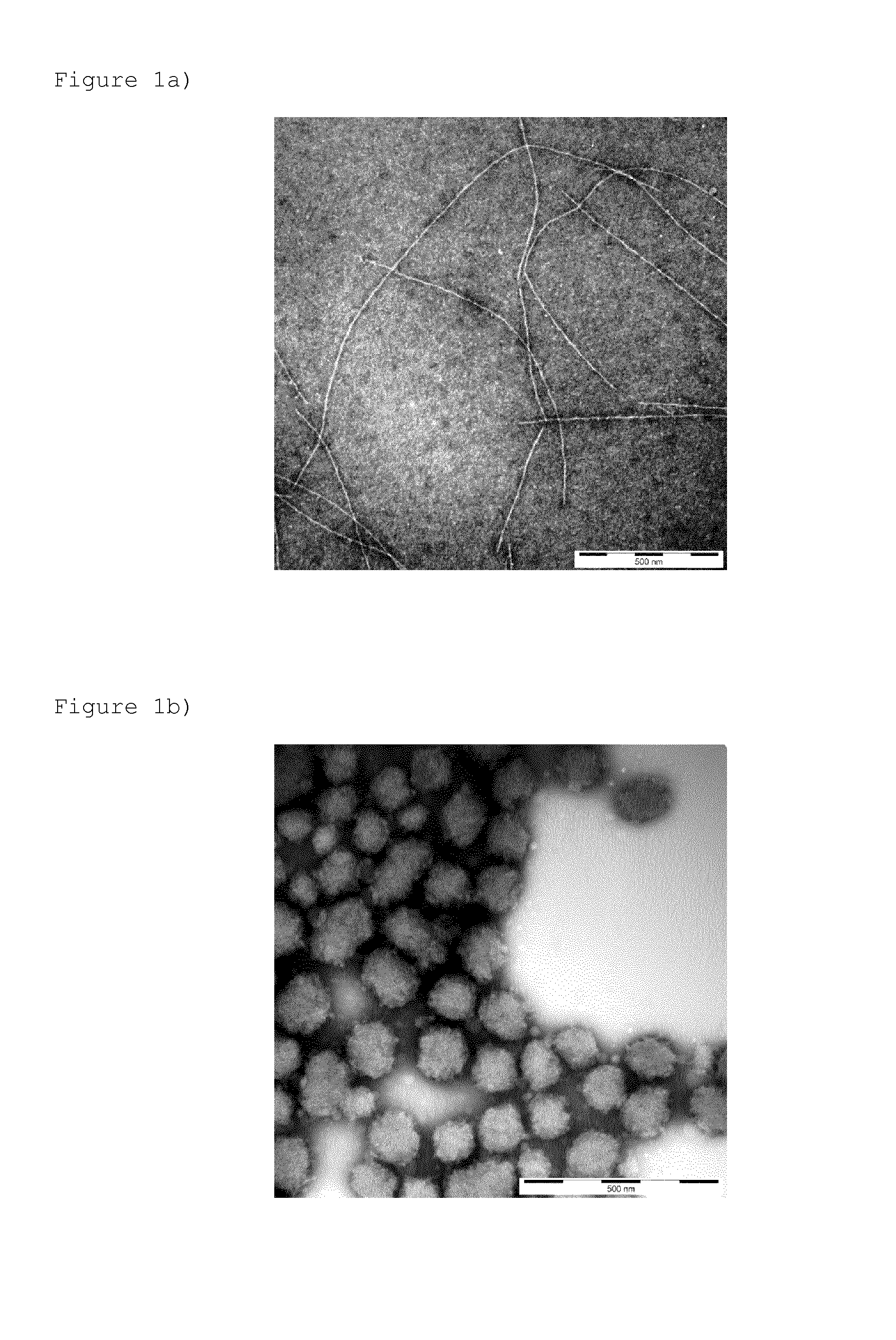Aerated food products with improved foam stability
a food product and foam stability technology, applied in the field of aerated food products with improved foam stability, can solve the problems of high energy and cost production of fibrils, limited foaming properties of aggregates, and drainage and phase separation, and achieve the effect of high intensity
- Summary
- Abstract
- Description
- Claims
- Application Information
AI Technical Summary
Benefits of technology
Problems solved by technology
Method used
Image
Examples
example 1
Preparation of Protein Aggregates
[0064]Three different structures and sizes of aggregates were prepared according to three different processes performed independently of each other according to the following procedure:[0065]β-Lactoglobulin isolate (Davisco Foods International, Inc., Le Sueur, Minn., USA) and demineralised water were mixed at room temperature and the pH was adjusted to 2.0 (fibrils), respectively 5.8 (spherical aggregates) and 7.0 (worm-like aggregates). The solution contained 4 wt % of β-Lactoglobulin isolate (equivalent to 3.46 wt % of β-Lactoglobulin).[0066]The solution was rapidly heated under gentle steering to T=90° C. (fibrils), respectively 85° C. (spherical aggregates) and 85° C. (worm-like aggregates) and kept at that temperature for 5 hours (fibrils), respectively 15 min (spherical aggregates) and 15 min (worm-like aggregates).[0067]The solution was rapidly cooled and then stored at T=4° C. Samples were taken to prove the aggregation status with help of el...
example 2
Foamability and Foam Stability of Mixtures of Aggregates According to the Invention
[0071]Method: Foamscan device (Teclis, Longessaigne, France) (air sparging), foamability and foam volume stability of different aqueous solutions of aggregates foamed to about 500% overrun with the help of nitrogen were studied. A foam of 120 cm3 was made from an initial liquid volume of 20 mL, at room temperature, using a frit with a porosity of 4, and a sparging rate of 80%.
[0072]FIGS. 2 shows the foam stability obtained with mixtures of fibrils together with spherical aggregates compared to aggregates used separately. The total protein content was kept the same, namely to 0.1%.
[0073]While the spherical aggregates by themselves did not foam at all, the other samples foamed. Looking at aggregates alone, protein fibrils provide the best results. But their stability is considerably reduced when their usage level is reduced by 50%. Unexpectedly, when this part of the fibrils is replaced by spherical agg...
example 3
Chocolate Mousses
[0078]The following recipes were used to prepare chocolate mousses:
[0079]Control
Protein contentweightProtein contentfor 100 g mousseChocolate100g 5%2g3 egg yolk50g16%3.2g3 egg white100g10%9.2g
[0080]Chocolate was melted at 50° C. before mixing with egg yolk. Egg white was foamed using a Hobbart mixer (speed 3, 1 min 20 sec). Foam was gently incorporated into the chocolate mix. The mix is then put at 4° C. for cooling.
[0081]Examples
Protein contentweightProtein contentfor 100 g mousseChocolate100g5%2g3 egg yolk50g16% 3.2gProtein100g4%1.6gaggregatessolution
[0082]Chocolate was melted at 50° C. before mixing with egg yolk. A protein aggregate suspension was foamed using a Hobbart mixer (speed 3, 1 min 20 sec). Foam was gently incorporated into the chocolate mix. The mix then put at 4° C. for cooling.
[0083]Tested Samples:
FibrilsSphericalWormsRef 3a4%——Ref 3b——4%Ref 3c—4%—3d2%2%—3e2%1%1%3f1%2%1%
[0084]The texture of the mousses were evaluated visually and using a spoon. Ref ...
PUM
 Login to View More
Login to View More Abstract
Description
Claims
Application Information
 Login to View More
Login to View More - R&D
- Intellectual Property
- Life Sciences
- Materials
- Tech Scout
- Unparalleled Data Quality
- Higher Quality Content
- 60% Fewer Hallucinations
Browse by: Latest US Patents, China's latest patents, Technical Efficacy Thesaurus, Application Domain, Technology Topic, Popular Technical Reports.
© 2025 PatSnap. All rights reserved.Legal|Privacy policy|Modern Slavery Act Transparency Statement|Sitemap|About US| Contact US: help@patsnap.com



